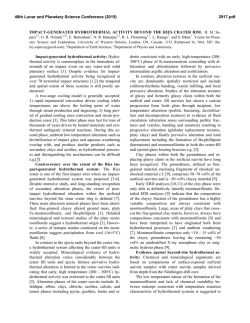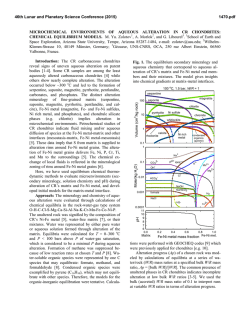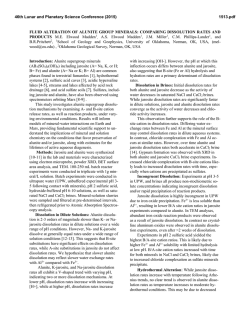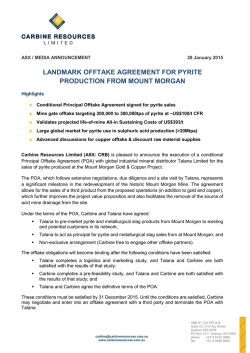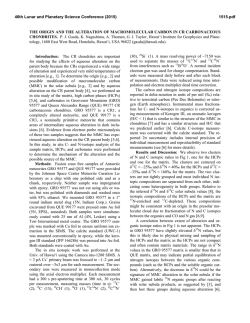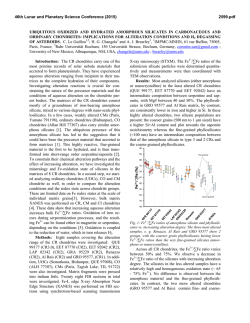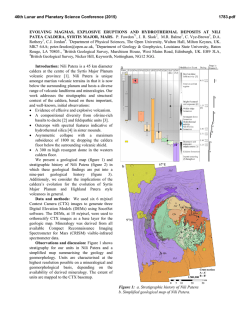
Environment of Ore Deposition in the Cerro Quema Gold-Copper
macla nº 13. septiembre ‘10 revista de la sociedad española de mineralogía 69 Environment of Ore Deposition in the Cerro Quema Gold-Copper Deposit (Azuero Peninsula, Panama) / ISAAC CORRAL (1,*), ESTEVE CARDELLACH (1), ÀNGELS CANALS (2), MERCÈ CORBELLA (1), TOMÁS MARTÍNCRESPO (3), ELENA VINDEL (4) (1) Departament de Geologia, Unitat de Cristallografia i Mineralogia. Universitat Autònoma de Barcelona. 08193, Barcelona (España). (2) Facultat de Geologia. Universitat de Barcelona. 08028, Barcelona (España) (3) Departamento de Biología y Geología. ESCET. Universidad Rey Juan Carlos. 28933, Madrid (España). (4) Facultad de Ciencias Geológicas. Universidad Complutense de Madrid. 28040, Madrid (España). INTRODUCTION. The Cerro Quema (CQ) Au-Cu deposit is located in the Azuero Peninsula, SW Panama (Fig. 1). Previous studies were carried out on the economic potential of gold mining in the area (Torrey and Keenan, 1994) and did not focus on understanding the genesis of the deposit. Therefore the origin of fluids related to the ore and alteration processes remained unclear. limestones, submarine dacite lava domes and by crosscutting basalticandesitic dikes, belonging to the Río Quema Formation (RQF), a fore-arc infill sequence (Corral et al., in press). The Cerro Quema Au-Cu deposit is constituted by several mineable bodies, named La Pava, Cerro Quemita and Cerro Quema, related to an E–W trending regional fault system. Estimated gold resources are 106 metric tonnes with an average gold grade of 1.26g/t (Torrey and Keenan, 1994). HYDROTHERMAL MINERALIZATION. fig 1. Location of the Cerro Quema Au-Cu deposit. In the present work, mineralogical, fluid inclusion and stable isotope data (ore and alteration minerals) are presented in order to understand the origin and evolution of the hydrothermal system in the Cerro Quema district. GEOLOGIC SETTING. Panama microplate is situated in the southern part of Central American and constitutes the youngest segment of the land bridge between North and South American plates. During Late Cretaceous this region was characterized by the subduction of the Farallon plate beneath the Caribbean plate. Subsequently, an arc-magmatism developed on top of the Caribbean plate. The Cerro Quema Au-Cu deposit is hosted by fore-arc basin rocks of this volcanic arc. The study area is constituted by volcanic and volcaniclastic sediments interbedded with hemipelagic AND The Cerro Quema deposit is characterized by the presence of a widespread hydrothermal alteration. The alteration pattern is clearly fault controlled, following E-W trending regional faults. Alteration develops concentric halos. Mineralization is hosted by andesites and dacitic lava domes of the RQF. A mineralogical study of the hydrothermal alteration has been carried out on surface and drill core samples from the La Pava, Cerro Quemita and Cerro Quema bodies, using optical microscopy, SEM-EDS and XRD. Results show an alteration pattern characterized by the presence of three zones: • An inner zone, characterized on surface by vuggy silica with hematite, goethite and rutile. At depth it has quartz, alunite-natroalunite, aluminium-phosphate-sulphate minerals (APS), dickite, barite, pyrite, enargite and rutile. This mineral paragenesis corresponds to the advanced argillic alteration zone. • An outer rim, composed of kaolinite, illite and interlayered illite-smectite in palabras clave: Cerro Quema, Alunita, Pirita, Isotopos Estables. resumen SEM 2010 ALTERATION both, surface exposures and at depth, corresponds to the argillic alteration zone. • A propylitic zone, only observed in drill core samples and apparently unrelated to the previous alteration zones, has pyrite, chlorite, calcite and siderite. The ore minerals consist of disseminated pyrite, chalcopyrite, enargite and a poorly developed stockwork of quartz, pyrite, chalcopyrite and barite with traces of galena and sphalerite. Gold occurs as disseminated microscopic grains of native goldand as “invisible gold” within the crystalline structure of pyrite (Corral, 2008), in the advanced argillic alteration zone. FLUID INCLUSION AND STABLE ISOTOPE DATA. Microthermometric data has been obtained from secondary fluid inclusions in primary quartz phenocrysts from the volcanic host rock affected by the advanced argillic alteration. Due the size (up to 10µ) only a few measurements could have been made. Fluid inclusions are biphase (L+V) at room temperature and depict homogenization temperatures (Th) from 190 to 230ºC (n=7) and melting ice temperatures (Tmi) from -0.1 to -3.0ºC (n= 5). Stable isotopes ratios have been analyzed on vuggy quartz, kaolinitedickite, alunite-natroalunite, pyrite, enargite and barite. The results are shown in Table 1. DISCUSSION The presence of vuggy silica, alunitenatroalunite and enargite in addition to the hydrothermal alteration pattern are compatible with a high sulfidation epithermal system. Assuming that secondary fluid inclusions key words: Cerro Quema, Alunite, Pyrite, Stable Isotopes. * corresponding author: [email protected] 70 δ18O δD δ34S Quartz Kaolinite Alunite +10.4 to +12.0 (n=3) +14.0 to +17.4 (n=4) +1.8 to +9.8 (n=8) – -30.0 to -44.0 (n=6) – – – +15.0 to +17.4 (n=4) Barite +2.7 to +11.6 (n=5) – +14.1 to +16.9 (n=5) Pyrite – – -7.2 to -11.7 (n=10) Enargite – – Table 1. Isotope values (in ‰) of the different mineral species. in quartz phenocrysts formed during the ore deposition-alteration stages, the Th/Tmi data indicate that the hydrothermal system was dominated by low salinity (up to 5% NaCl eq.) and moderate temperature (190-230°C) fluids. With a mean deposition temperature of 240°C (data from pyrite-alunite isotope geothermometry), the δ18O of the fluid in equilibrium with vuggy quartz, calculated from the equation of Mathsuhisa et al., (1979), ranged from +1.0 to + 2.6‰, pointing to the presence of surface waters in the system during vuggy quartz precipitation. For a similar temperature, calculated δD and δ18O of hydrothermal fluids during kaolinite-dickite formation, ranged from -46 to -60‰ and from +10.3 to +13.7‰, respectively (using the equations of Gilg and Sheppard, (1996) and Sheppard and Gilg, (1996) for deuterium-water and oxygen-water fractionations). The high δ18O values suggest an isotopic exchange of mineralizing fluids with host and enclosing rocks, especially volcaniclastic sediments and limestones, during kaolinite-dickite formation. The high δ34S values of alunite (≈+17‰) together with the negative values of coexisting pyrite and enargite are compatible with a magmatic hydrothermal origin of alunite (Rye et al., 1992). The δ34S values of barite, similar to alunite, suggest a related sulfur source. The δ34S values of pyrite and enargite coexisting with alunite, reflect a isotopic -9.3 to -11.2 (n=2) equilibrium between H2S and SO42- in the fluids (Fig. 2). If this is the case, coexisting pyrite-alunite pairs give equilibration temperatures between 224 and 274°C (Ohmoto and Rye, 1979), slightly higher than the Th’s measured in the fluid inclusions. This difference might be due to the P effect on the trapping temperature of the fluids during mineralizing event. deposition took place from fluids of low salinity up to 5% wt NaCl eq.) and moderate temperatures≈240°C). ( S isotope data of sulfides and sulfates indicate a sulfur source of magmatic origin. O and D data of silicates and sulfates (quartz, kaolinite, alunitenatroalunite and barite) suggest an important contribution of surface fluids during sulfate precipitation and hydrothermal alteration. ACKNOWLEDGMENTS. This study was supported by the Spanish Ministry of Science and Education (MEC) project CGL2007-62690/BTE, a predoctoral grant of the “Departament d’Universitats, Recerca i Societat de la Informació” (Generalitat de Catalunya) and a SEGF (2009 and 2010) student In contrast with the sulfur isotope research grant (Hugh E. McKinstry). We 18 composition, the δ O of alunite shows thank Bellhaven Copper and Gold Inc. a wider range of values (+1.8 to for access to mine samples and drill +9.8‰). Calculated δ18O of fluids in cores used in this study. equilibrium with alunite (using the equation of Stoffregen et al, 1968) at a REFERENCES. temperature of 240°C, range from -1 to +7‰. However, calculated δ18O of Corral, I. (2008): El dipòsit d’Au-Cu de “La fluids during barite precipitation (using Pava” (Península d’Azuero, Panama): the equation of Lloyd, 1968), range caracterització geológica i mineralógica. from +4 to +4.8‰. These dada suggest MSc. Universitat Autònoma de Barcelona. a mixing in different proportions Corral, I., Griera, A., Gómez-Gras, D., Corbella, M., Canals, À., Pineda-Falconett, M., between surface and magmatic fluids Cardellach, E. (in press): Geology of the during alunite-natroalunite and barite Cerro Quema Au-Cu deposit (Azuero precipitation. CONCLUSIONS. The Cerro Quema Au-Cu deposit formed due to a high sulfidation hydrothermal system as deduced from the mineralogy and geochemical data. Mineralization is related to E-W trending faults that affected dacite lava domes and andesites of the RQF. Ore mineralogy is constituted by native gold, pyrite, chalcopyrite, enargite, and minor amounts of sphalerite and galena. Hydrothermal alteration is represented by an advanced argillic, argillic, and minor propylitic halos. Ore fig 2. δ34S values of al: alunite, ba: barite, en: enargite and py: pyrite Peninsula, Panama). Geol. Acta. Gilg, H.A. & Sheppard, S.M.F. (1996): Hydrogen isotope fractionation between kaolinite and water revisited. Geochim. Cosmochim. Ac., 60, 529-533. Lloyd, R.M. (1968): Oxygen isotope behavior in the sulfate-water system. J. Geophys. Res., 73, 6099-6110. Mathsuhisa, Y., Goldsmith, H.J.R., Clayton, R.N. (1979): Oxygene isotopic fractionation in the system quartz-albite-anorthite-water. Geochim. Cosmochim. Ac., 43, 1131-1140. Ohmoto, H. & Rye, R.O. (1979): Isotopes of sulfur and carbon. In “Geochemistry of hydrothermal ore deposits”. John Wiley & Sons, New York, 509-567. Rye, R.O., Bethke, P.M., Finkelstein, D.G. (1992): The stable isotope geochemistry of acid sulfate alteration. Econ. Geol., 87, 225262. Sheppard, S.M.F. & Gilg, H.A. (1996): Stable isotope geochemistry of clay minerals: The story of sloppy, sticky, lumpy and tough, Cairns-Smith (1971). Clay Miner., 31, 1-24. Stoffregen, R.E., Rye, R.O., Wasserman, M.D. (1994): Experimental studies of alunite 18O16O and D-H fractionation factors between alunite and water at 250–450ºC. Geochim. Cosmochim. Ac., 58, 903-916. Torrey, C. & Keenan, J. (1994): Cerro Quema Project, Panama, Prospecting in tropical and arid terrains: Toronto, Ontario, Canada.
© Copyright 2025
